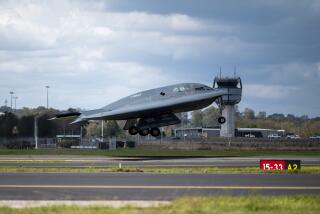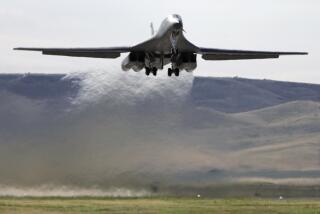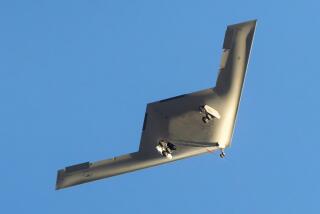Air Force’s new stealth bomber will replace B-1s and B-2s while older B-52s keep flying

Air Force plans to phase out its B-1B and B-2 bomber fleets as the new B-21 bomber, currently being built in Palmdale by Northrop Grumman Corp., becomes operational in the mid-2020s, according to a report.
The U.S. Air Force plans to phase out its B-1B and B-2 bomber fleets as the new B-21 bomber, currently being built in Palmdale by Northrop Grumman Corp., becomes operational in the mid-2020s.
That would leave the Air Force of the future with the B-21 and the aging B-52 Stratofortress bomber, which first became operational in 1952, during the Truman administration. Both the B-1B and the B-2 are decades younger, faster and present smaller radar targets than the B-52. But the older plane can carry a lot of weapons and it’s far cheaper to operate.
Air Force Secretary Heather Wilson said in a statement Monday that the service will update its B-52 bombers, which like the B-2 and B-21 can carry nuclear weapons. She said the Air Force would fund development of replacement engines for the B-52 and that it would continue to modify the B-1B and B-2 aircraft “to keep them relevant until the B-21s come on line.”
The timeline of the planes’ retirement will depend on the B-21 production and delivery schedules.
The news was first reported Sunday by trade publication Aviation Week.
The Air Force’s active bomber fleet is currently comprised of 75 B-52s, 62 B-1Bs and 20 B-2s. The service has said it plans to buy 100 B-21s by the mid-2030s for at least $80 billion, though the exact amount is classified.
Mark Gunzinger, senior fellow at the Center for Strategic and Budgetary Assessments, said the move to phase out the B-1Bs and B-2s is likely budget-driven. The Air Force needs to modernize and reinvest in a number of its key assets, including its fighter jets, bomber forces and unmanned systems, and that is a “daunting challenge.”
But he said the phase-out would exacerbate an already-existing shortage in long-range strike capability.
“Premature retirement of viable long-range strike weapons is just going to make that problem worse,” Gunzinger said. “I would keep the B-2s as long as they have useful operational lives. I would try to get every year I can out of them.”
Originally envisioned as a fleet of 132 nuclear-capable bombers, the Air Force ended up getting only 21 B-2 aircraft as costs increased and the Cold War ended, leading to questions about why the aircraft was needed. The B-2 was ready for combat by 1997.
That small number of planes meant that the cost per flying hour is more expensive than that of the other two current bombers. But Gunzinger said a lot of money has been put into the B-2 over the years to “improve their capabilities.” Stealth maintenance and technology has improved over the years, but overhauling a B-2 bomber has traditionally been a major, and costly, task.
Even the conventional bomber B-1B, which was ready for combat in 1986, is newer than the B-52. Gunzinger said there have been several discussions over the years about replacing the B-52’s engines to decrease maintenance costs and increase fuel efficiency, a plan that could cost $7 billion or more.
“From a strategic perspective, from a force planning perspective, prematurely retiring bombers doesn’t make sense,” he said.
Gen. Robin Rand, Air Force Global Strike Command commander, said in the Monday statement that the B-52 has a projected service life through 2050 “with an adequate sustainment and modernization focus” that would help the plane continue to be a “key part of the bomber enterprise well into the future.”
Twitter: @smasunaga
UPDATES:
11:25 a.m.: This article was updated with confirmation from the Air Force of the B-1B and B-2 phase-out plan.
This article was originally published at 10:10 a.m.
More to Read
Inside the business of entertainment
The Wide Shot brings you news, analysis and insights on everything from streaming wars to production — and what it all means for the future.
You may occasionally receive promotional content from the Los Angeles Times.











